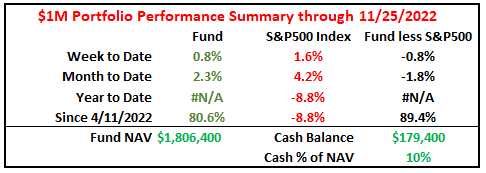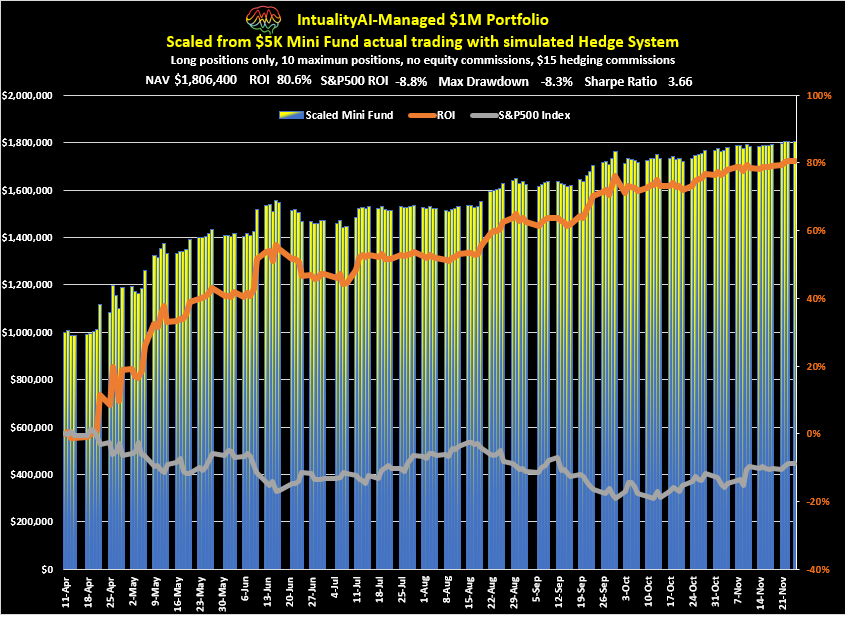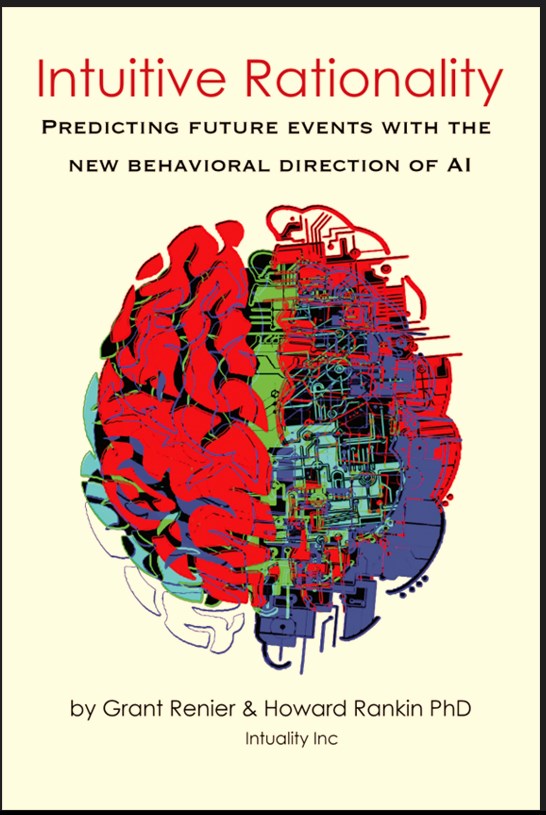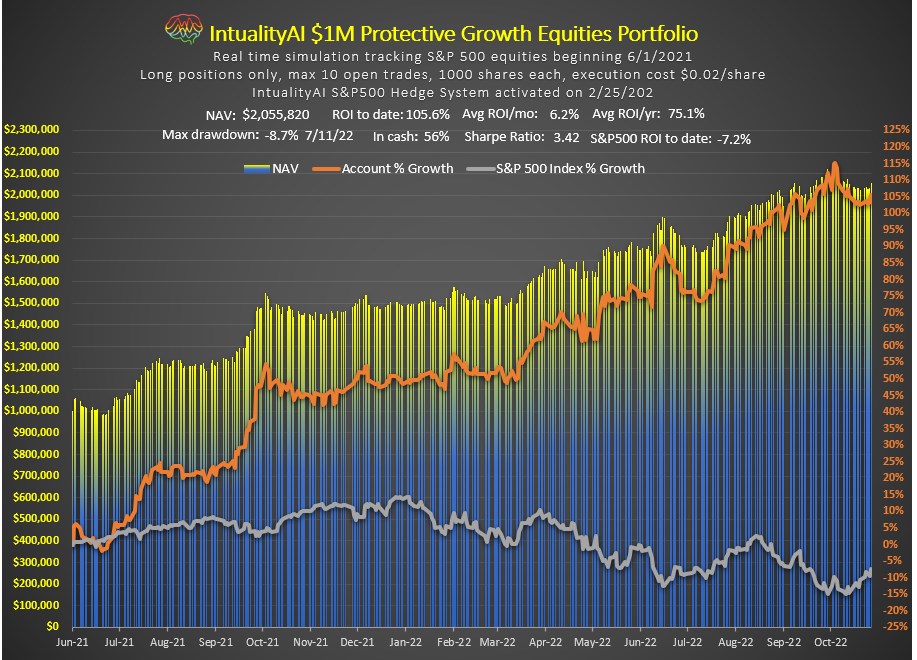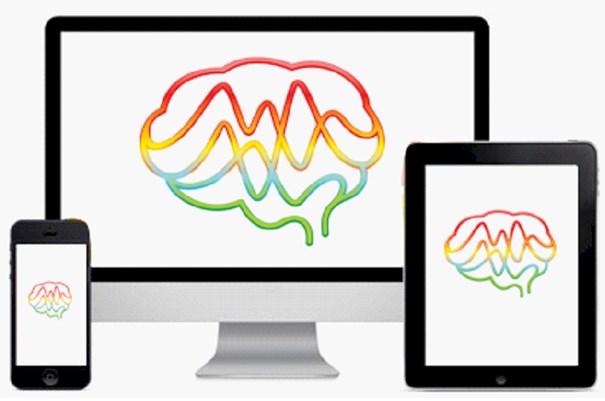
November 25, 2022
Don’t you think that the environment influences your thoughts and feelings?, by Howard Rankin
There exists an evil in the continual overload of random meaningless information, by Michael Hentschel
Game wagering spreads already discount home field advantage, by Grant Renier
This New Chart scales our real-trading Mini Fund for a more accurate $1M trade-by-trade portfolio performance record.
It replaces the previous hypothetical $1M portfolio that can still be viewed on our website using the password, below.
Don’t you think that the environment influences your thoughts and feelings?
“Why do you insist on spending so much time at the crime scene?” asked Watson.
“Where do you think it more likely I will get the information and ideas to solve the case?” asked Holmes. “At the Pub at Piccadilly or at the crime scene?”
“I’m not sure what you mean,” said Watson.
“Don’t you think that the environment influences your thoughts and feelings?

It’s possible that I might get clues and information about the crime while at the pub, but much more likely at the crime scene,” said Holmes
“Are you talking about feelings or ideas?” asked Watson.
“What’s the difference? They are all data points that shape the thought process,” said Holmes.
The environment, both internal and external, can shape the thought process and can present data that will influence decision-making. There’s the famous study in which judges were shown to give harsher sentences the hungrier they were. The external environment, especially the social environment, influences how “data” is interpreted. There’s the well-known Solomon Asch experiment in which participants chose an obviously wrong answer about the length of lines in a drawing, when they saw other participants chose the ‘obviously’ wrong answer. It’s unclear how many of the people in the study knew they were giving the wrong answer, or thought they had misunderstood the task, or seriously believed that they were correct.
The environment, however, doesn’t just offer clues that can divert the thought process, it can provide critical information. For example, Sherlock might be lingering at the crime scene for hours and realize that as time wore on the environment got more humid and he started to sweat. This realization could lead to a re-evaluation of the evidence and the timing of events depending on moisture content of the “clues”, or even the role of increased humidity on the mindset of the perpetrator and victim.
The environment, therefore, influences our awareness and use of data that might be relevant for solving the crime.
by Howard Rankin PhD, psychology and cognitive neuroscience
There exists an evil in the continual overload of random meaningless information
Big data is not enough. An AI remains an Idiot if its information flow is unrefined. The question is what the AI is enabled to see, what it is encouraged to interpret, and what it is allowed and programmed to perceive. Perception precedes reality.
There exists an evil in the continual overload of random meaningless information, whether big or small. Even if an AI is allowed to process infinite amounts of data, only the human mind at present is trained to find meaning in the data. That may be limited to human-oriented meaning, but that is at present still the main source of human economic value, monetization, and efficient practicality.

Any AI is capable of more data analytics than any human. But humanized AI also consults a wider data environment. In order to get value out of additional data streams, there has to be a mechanism to evaluate that there is a relevant relationship and correlation. This confers an additional advantage of some predictability, even if direct causation is not involved. This is how humans subconsciously intuit and use available knowledge from their environments.
Humanized AI can select the most meaningful data from all data streams available in the environment. This adds a much wider search for relevant data, and this creates advantages in making more reliable predictions. Seeing a wider perspective informs wisdom in humans, and IntualityAI replicates this by looking for correlations and relevance that might otherwise escape attention, even from seemingly irrelevant data streams. Finding the hidden indicators of valuable information can make the difference for correct inferences.
Prediction is not based on massive past data but on the subtle and inferential changes in current data streams. The data that truly matters is immediate changes to the present environment. Continual awareness (superior in most respects what human awareness can handle) enables recognition that a new event or something new is important and therefore relevant.
Humans dream of probabilities and future potentials. Computers are only taught rationalistic formulaic processing, not intelligent thinking. At best, computer AI replicates what humans do best, and does that faster and more accurately, with fewer mistakes. Future probabilities are as yet not on the menu. Structured data today is actually a limitation on how data should be most effectively and efficiently (and humanly) processed for its inherent meanings. IntualityAI specifically seeks out unstructured data streams not yet burdened with artificial biases.
As with humans, past biases and typical reactions to changing data inform how an AI can see the world. This can expand the fundamental AI advantage of handling massive data across massively wide information sources, to also complete a recognition of what is important to human action and reaction. Computer predictions are as a result more relevant to what humans ultimately want to do with the predictions.
IntualityAI produces a new form of intuitive intelligence. Perceptive Insights can be monetized. Unlike all other AI’s today, IntualityAI’s Humanized Logic represents a new foundation for hybrid computing. Not just a theoretical framework, IntualityAI is already hard at work succeeding in complex tasks of intelligently simplifying past big data into a set of useful information correlations, accepting larger volumes and wider scopes of potentially relevant data streams, and creating more widely aware observations and predictions.
by Michael Hentschel, Yale and Kellogg anthropologist, economist, venture capitalist
Game wagering spreads already discount home field advantage
Each independent application of humanized AI is represented by the data inputted into it. These selected data inputs describe the application Environment. In an NFL football game prediction application, each team is defined by data from previous games as to their prior performance as a team, by players, for each down, the weather, the time of day, the type of field, etc. These inputs describe the Environment for the upcoming simulated game. Obviously, the system can know no more about the impending game than what is available to it from the inputted data.
We know that the environment of the game is constantly changing up to and even

during game time. More than just the changing condition of players during the previous week (injured reserve), weather changes, pundits influence our opinions and wagering behavior, all to the point where we can express a changing Environment bias. Humanized AI treats environment as a bias and includes heuristics that constantly recalculate its value and relevance.
Herbert Simon, Carnegie Mellon professor and 1960's leader in behavioral science, used the analogy of a pair of scissors, where one blade represents "cognitive limitations" of actual humans and the other the "structures of the environment", illustrating how minds compensate for limited resources by exploiting known structural regularity in the environment.
Gerd Gigerenzer, Director Emeritus of the Center for Adaptive Behavior and Cognition (ABC) at the Max Planck Institute for Human Development, states, “. . agents react relative to their environment and use their cognitive processes to adapt accordingly.”
Humanized AI allows the user to input as many data sources as possible that are thought to influence the objective of predicting the output of the game. It manages the limits of the application environment by determining the degree of influence of each input on the overall goal, in this case the predicted outcome of the game, by applying an environment bias heuristic to each data source. Each data input carries its own dynamic environment bias value for correlation to the application goal – the predicted yards gained or lost by each team during the game and final totals. Environmental influencer data inputs either have a significant or minimal effect of the yards gained or lost in prediction of game's play-by-play sequence.
A recent case with the NFL football application has shown no discernible advantage of inputting home team advantage as an influencer and was reported as such. It is assumed that the game wagering spread input includes the discounting for home field advantage. Therefore, the separate input of that data was discontinued.
by Grant Renier, engineering, mathematics, behavioral science, economics
This content is not for publication
©Intuality Inc 2022-2024 ALL RIGHTS RESERVED
